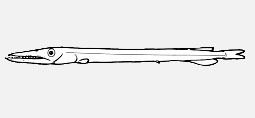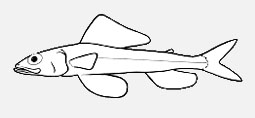
Alepisauridae - (Lancetfishes)
Distribution: Atlantic and Pacific Oceans. Elongate and subcylindrical body. Scaleless, but covered with pores. No light organs. Dorsal fin high and long with 29-48 rays. Low anal fin; rays 12-18. Pelvics insertion abdominal; rays 8-10. Large mouth with well developed teeth. Palatines distinctively long. Vertebrae 47-51. No swim bladder. Maximum length 2m.
Synonym of Alepisauridae; Davis, 2010. Distribution: Antarctic, Atlantic, and Pacific. Dorsal fin absent. Well developed adipose fin. Scaleless. Photophores absent. Minute pelvic fin; fin rays 9-11. Pectoral fin with 12-15 rays. Vertebrae 78-83.
Distribution: tropical and subtropical seas; Atlantic (including the Mediterranean) and Pacific). Slender. Caudal peduncle with fulcral scales. Origin of dorsal fin in anterior third of body; dorsal rays 14-22. Anal fin with 9-13 rays. Pelvic fin with 9 rays; thoracic. Pectoral fin with 11-14 rays; lateral. Scales cycloid or ctenoid, found in both head and body. Supramaxillae 2. Orbitosphenoid present. Vertebrae 36-53. As Aulopodidae in Nelson (1994).

Bathysauridae - (Deepsea lizardfishes)
Head very depressed; upper jaw long, extending well past rear eye; scales along lateral line enlarged. These bottom-dwelling deepsea fishes are hermaphrodite. Maximum length: 78 cm.

Bathysauroididae - (Largescale deep-sea lizardfishes)
Distribution: Western Pacific. Suggested new common name for this family from Ref. 58418.
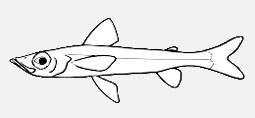
Chlorophthalmidae - (Greeneyes)
Distribution: Atlantic, Indian, and Pacific Oceans: tropical and warm temperate marine waters on the upper continental slope, benthic; in the Indo-Pacific at depths of 200-605 m, in the Atlantic at 50-1,000 m (Ref. 123109). Morphology: Supramaxilla single and elongate; eyes large, normal; pseudobranch present; tip of upper jaw not extending beyond orbit; pyloric caeca present; dorsal fin rays 9-13; anal fin rays 7-11; pectoral fin rays 15-19; branchiostegal rays 8; vertebrae 38-50 (Ref. 7463); lateral-line scales > 46; scale rows above lateral line > 3; snout profile straight or slightly concave, its length in horizontal orbit diameter 1.0-1.8; anterior part of lower-jaw teeth exposed with vomerine teeth of moderate size; palatine teeth minute, restricted to anterior half of bone; posterior tip of upper jaw not extending beyond vertical through eye center; origin of dorsal fin posterior to vertical through pelvic-fin origin; anus very close to pelvic-fin base; light organ present near anus (Ref. 123109). Synchronous hermaphrodites, developing ovaries and testicles at the same time; their larvae are pelagic and may be found near the surface (Ref. 123109). Diet: feed on benthic invertebrates like small crustaceans and squid (Ref. 123109).

Evermannellidae - (Sabertooth fishes)
Distribution: Atlantic, Indian, and Pacific. Mesopelagic; chiefly tropical and subtropical. Head and body without normal scales. Tail showing three distinct bands of muscle tissue (epaxial, midlateral, and hypaxial). Tongue toothless. Frontmost palatine tooth much elongated. Size of eye ranging from small to large; mostly tubular. Dorsal fin 10-13 rays. Anal fin 26-37 rays. Pectoral fin 11-13 rays. Swim bladder absent. Vertebrae 45-54. Maximum length about 18 cm. Predaceous.
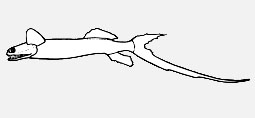
Giganturidae - (Telescopefishes)
Distribution: Atlantic, Indian, and Pacific Oceans. Large and tubular eyes, directed forward. Large mouth extending well behind the eyes. Mouth with sharp depressible teeth. Pectoral fins set high, above gill opening. No scales on body. Pelvic or adipose fins absent. Caudal fin forked; some rays in lower lobe elongated. Without premaxilla, orbitosphenoid, parietal, gill rakers, symplectic, branchiostegal rays, posttemporal, or supratemporal. Swim bladder absent. Silvery in color. Probably neotenic, i.e., retaining larval characters. Only two species according to Ref. 4537.

Ipnopidae - (Deep-sea tripod fishes)
Distribution: Atlantic, Indian and Pacific Oceans. Eyes minute or large (Bathysauropsis), or plate-like and lensless (Ipmops); pseudobranch absent in adults; tip of upper jaw extending past orbit; pyloric caeca absent; dorsal fin rays 8-16; anal fin rays 7-19; pectoral rays 9-24; branchiostegal rays 8-17; vertebrae 44-80; the 18 species of Bathypterois have elongated pectoral, pelvic and caudal rays. Suggested new common name for this family from Ref. 58418.

Lestidiidae - (Naked barracudinas)
Two tribes: Tribe Paralepidini (4 genera, 11 species), characterized by having a relatively low number of vertebrae, and a body that is usually rather massive and fully scaled. Tribe Lestidiini (7 genera, at least 55 species), usually with a transparent or near-transparent slender body lacking scales (except for the lateral line), and has a relatively high number of vertebrae (Ref. 123138).
Distribution: Subarctic to Subantarctic waters. Dorsal fin 9-14 rays. Anal fin 16-21 rays. Pectoral fin 10-15 rays. Scales in lateral line 44-65. Swim bladder absent. Without photophores. Maxillary teeth present in larvae. Vertebrae 42-66.
synonym of Alepisauridae; Davis, 2010. Distribution: Atlantic and Indian Oceans. Scaleless. Dentary each with a huge fang. Body poreless. Dorsal fin with 9-12 rays. Anal fin with 14-16 rays. Pectoral fin rays 11-13. Swim bladder absent. Vertebrae 39-41. Suggested new common name for this family from Ref. 58418.

Paralepididae - (Barracudinas)
Distribution: circumglobal. Origin of dorsal fin in mid-trunk. Dorsal fin rays 7-16. Anal fin with a long base; fin rays 20-50. Pectoral fin with 11-17 rays. With or without scales on body. Swim bladder lacking. Vertebrae 53-121. Look similar to sphyraenids. Length can reach up to 1 m.
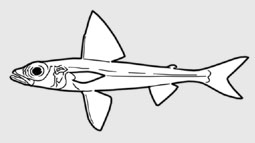
Paraulopidae - (Cucumber fishes)
Marine. Tropical to temperate, benthic, outer continental shelf and upper continental slopes. Indian and western Pacific (southern Japan and Emperor Seamounts south to Australia and New Zealand). Dorsal fin ray 10 or 11; anal fin rays 8-11; pectoral fin rays 13-20; pelvic fin ray 9; pored lateral line scales 40-52; vertebrae usually 39-46 (Ref. 58010). This clade was recognised based on six apomorphies, primarily characters in the branchial arches, intermuscular bones, caudal skeleton, and pelvic girdle. Maximum length 35 cm (Ref. 41636). Common name for this family encoded from Ref. 58010.

Pseudotrichonotidae - (Sand diving lizardfishes)
Distribution: Izu Peninsula, Japan. Body elongate and cylindrical. Relatively small mouth. Premaxillaries alone border the upper jaw. Complete lateral line, running midlaterally. Scales cycloid. Lateral line scales 46-48. Dorsal fin with about 33 soft rays. Anal fin with 14 or 15 rays. Pelvic fins inserted beneath dorsal fin origin. Pelvic rays 7: long. Principal caudal rays 17. Adipose fin and photophores lacking. No swim bladder. Without orbitosphenoid and mesocoracoid. Branchiostegal rays 6. Vertebrae 48-50: abdominal 23 or 24, caudal 25 or 26. Reportedly diving into sand. Suggested new common name for this family from Ref. 58418.
Distribution: Antarctic, Atlantic, Indian, and Pacific. Scales cycloid. Whole body and postorbital region with scales. Lateral line scales 40-65. Tongue with strong and usually hooked teeth. Eyes large and tubular, oriented upward or slightly dorso-anteriorly. Dorsal fin 5-10 rays. Anal fin with up to 39 rays; usually 17-27. Pectoral fins with 18-28 rays. Postcleithra 2. Swim bladder absent. Vertebrae 40-65. Maximum length about 23 cm. Adults usually found in depths of 500-1,000 m; larvae usually occuring in 100-200 m.
Chiefly marine; rarely brackish. Distribution: Atlantic, Indian, and Pacific Oceans. Supramaxilla small, if present. Branchiostegal rays 8-26. Vertebrae 39-67. Non-hermaphroditic, except in the monoecious Bathysaurus. Small cylindrical fishes with spineless fins and large mouth full of slender sharp teeth, even on tongue. Voracious predators of small fishes.
Note: Families with unknown counts of dorsal or anal spines are also included
